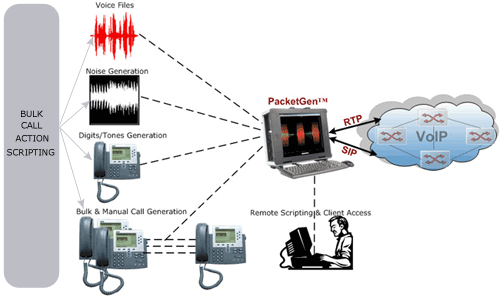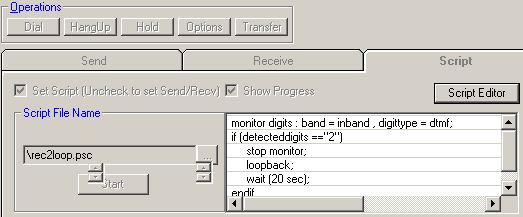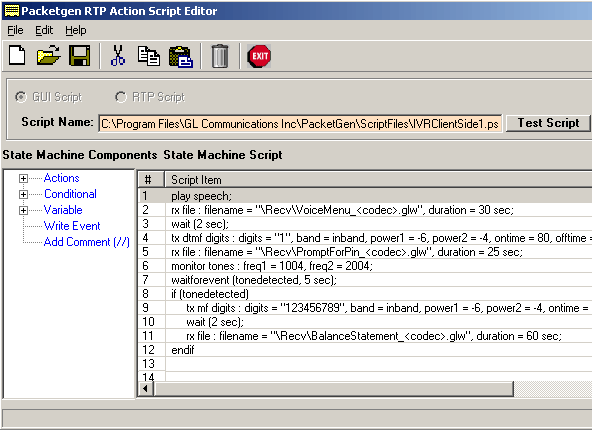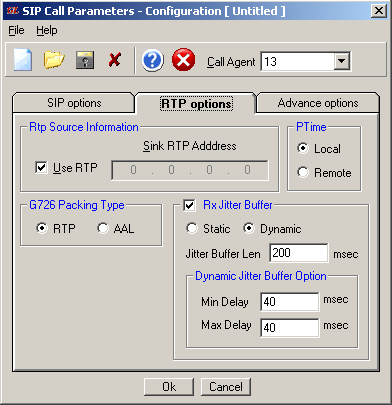Newsletter: GL Announces the Release of PacketGen™ Ver 3.0 with Enhanced Features for Automation & Network Wide Voice Quality Testing
Welcome to the September issue of GL Communications' Newsletter about the latest release of PacketGen™ software.
GL has enhanced its VoIP Testing tool PacketGen™ a software based VoIP Testing tool for real-time VoIP bulk call generation, stress testing, and analysis of VoIP networks and equipment. PacketGen™ supports SIP call generation (individual calls as well as bulk calling) and RTP/RTCP traffic generation. Traffic actions include sending/receiving voice files, user-defined digits and tones, noise impairment and real-time voice traffic.

New features allow PacketGen™ to be used in diverse applications:
- Automated Testing
With CLI (Command Line Interface), PacketGen™ can be integrated into an automated test environment. Users can write their own scripts and run them at the windows command line. This feature can replace the manual Graphical User Interface.
- Network Wide Voice Quality Testing
PacketGen™ can be deployed throughout the VoIP network for generating calls and traffic. Once configured, PacketGen™ can automatically generate and receive calls, using the RTP traffic-scripting feature, and synchronous voice file transmission and reception. PacketGens running at various ends of the network combined with GL's VQT software running at a central location, network wide voice quality can be actively measured and monitored.
A brief summary of the new features and enhancements introduced to PacketGen™ Version 3.0 are:
- Command Line Interface (CLI) for Automation
PacketGen™ has been enhanced with command line capability (CLI). CLI provides almost all Graphical User Interface features, through simple text commands. CLI allows the users to control multiple SIP cores, just like the Graphical User Interface. CLI can be used as an effective replacement for the Graphical User Interface. With CLI, PacketGen™ can be integrated into an automated test environment. Also, CLI makes it easy to integrate PacketGen™ into third party applications. - Perform RTP "traffic actions" through powerful Scripting
This new feature provides the users a new way to perform RTP traffic actions through user-friendly scripts. RTP action scripting provides the users with greater control and flexibility over RTP traffic generation. Users can configure scripts to perform various traffic actions once a call has been established. Commands are available to perform all Graphical User Interface functions such as send / record voice files, send / detect in-band and out-band DTMF and MF digits as well as tones, loop the RTP stream back to the sender, and direct the audio to the computers microphone and speaker. It also provides features like conditional branching (if else statements), wait on event, loops, goto statements and user defined messages. Each call can be configured for a unique script, or a single script can be used within many calls. Users can load scripts and view script progress in real time, in the Manual and Bulk call screens and in Auto Action.
- RTP Script Editor
PacketGen™ now includes a RTP Script Editor to easily build RTP Action scripts. RTP Script Editor is a Graphical User Interface application which allows an intuitive point and click script setup. In a distributed system, the script editor can be used to create and edit script files on all computers running SIP/RTP cores from a central site.The editor contains all Graphical User Interface functions such as send / record voice files, send / detect in-band and out-band DTMF and MF digits as well as tones, loop the RTP stream back to the sender, and direct the audio to the computers microphone and speaker. These functions are used to build multi-level actions using control commands such as IF, IF NOT, ELSE...IF, END IF, LOOP, increment variable, write event, among many others.

- Receive Jitter Buffer control
PacketGen™ uses a jitter buffer in the receive direction to handle jitter caused by transmission over a VoIP network. Earlier versions of PacketGen™ had a default static jitter buffer. In this PacketGen™ ver 3.0 , control over jitter buffer has been provided. This is a global run time control and applies to all RTP streams. The Users can configure static or dynamic jitter buffers and their lengths. Also, the users have the option to turn on/off the jitter buffer.

- G729B codec
G.729B codec (G729 Annex B) is now added to the existing list of supported codecs (G.711, G.726, GSM, G.729A) in PacketGen™ and AFCU. G.729 is an audio compression standard that offers low delay and effective bandwidth utilization. G729B is indicated in the SDP using the fmtp annexb attribute. - Configuring Packetization time (Ptime) for RTP traffic
Earlier implementations of PacketGen™ assumed the audio packets with standard packetization interval of 20ms. However, with the latest version, users can set the required value for the Ptime attribute of Session Description Protocol (SDP). Each end (Calling party/Called Party) can propose its own Ptime as part of Offer/Answer media negotiation during call setup. Based on the set Ptime value, the media packets are constructed while generating Real-time Protocol (RTP) packets. Also, option to use the local/remote end's ptime value has been provided. - User-defined Payload Types
The Payload numbers used for all the supported codecs can now be defined by the user before initiating the sessions. The user can edit a codec to Payload number mapping table as a part of the User Agent Configuration. This option allows PacketGen™ to handle the signaling with different payload types. - G726 codec packing type
Earlier implementations of PacketGen™ supported only the RTP packing type for G726 codecs. However, with the latest version, AAL packing type is also added. The users can select the required packing type at run time. This is a global setting and applies to all G726 RTP streams. - Audio Stream Utility
The existing "Playback" feature is used to play the selected call to speaker on the local computer (SIP/RTP core). To allow these calls to be heard from remote systems, GL has introduced Audio Stream Utility with PacketGen™. This utility automatically streams the voice of a selected call to a speaker on a remote system. - RTP Updates
RTP has been optimized to give better Start Action delays and to increase the number of simultaneous RTP sessions handled. - User Agent Registration and UAC/UAS Authentication changes
PacketGen™ includes the following changes in the UA Registration and UAC/UAS Authentication screens: - Automatic ReRegistration
PacketGen™ allows User Agents (UA) to be registered to a SIP Registrar Server. The Re-register option provides the ability to automatically register with the Registrar as soon as the registration period expires, without any user intervention. This process repeats continuously (i.e. PacketGen™ always keeps refreshing registrations) until users DeRegisters manually. - Lengths of UserName and Password fields
Lengths of UserName and Password fields in UAC/UAS Authentication screens have been increased to 64 characters - GL's Audio File Converter Utility (AFCU) and, Command line interface (CLI)
The Audio File Converter Utility (AFCU) is an accompanying application that converts any voice file, encoded as G.711, G.729ab, G.726, or GSM, into *.glw file format and vice versa. The Auto FCU (part of AFCU) is generally used in conjunction with GL's VQT application and converts degraded voice files from their native codec format to a standard format used by VQT. A new Command line interface (CLI) has been added to the AFCU. Using the commands, the users can load, start, and stop Auto FCU configurations. Also, commands are provided to convert a single file from glw to pcm and vice-versa
For comprehensive information on GL Communications' PacketGen™ click here.
 Back to Latest News Page
Back to Latest News Page